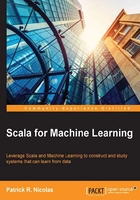
Conventions
In this book, you will find a number of text styles that distinguish between different kinds of information. Here are some examples of these styles and an explanation of their meaning.
Code words in text, database table names, folder names, filenames, file extensions, pathnames, dummy URLs, user input, and Twitter handles are shown as follows: "Finally, the environment variables JAVA_HOME, PATH, and CLASSPATH have to be updated accordingly."
A block of code is set as follows:
[default]
val lsp = builder.model(lrJacobian)
.weight(wMatrix)
.target(labels)
When we wish to draw your attention to a particular part of a code block, the relevant lines or items are set in bold:
[default] val lsp = builder.model(lrJacobian) .weight(wMatrix) .target(labels)
The source code block is described using a reference number embedded as a code comment:
[default] val lsp = builder.model(lrJacobian) //1 .weight(wMatrix) .target(labels)
The reference number is used in the chapter as follows: "The model instance is initialized with the Jacobian matrix, lrJacobian (line 1)."
Any command-line input or output is written as follows:
sbt/sbt assembly
New terms and important words are shown in bold. Words that you see on the screen, for example, in menus or dialog boxes, appear in the text like this: "The loss function is then known as the hinge loss."
Note
Warnings or important notes appear in a box like this.
Tip
Tips and tricks appear like this.
Note
Mathematical formulas (optional to read) appear in a box like this
For the sake of readability, the elements of the Scala code that are not essential to the understanding of an algorithm such as class, variable, and method qualifiers and validation of arguments, exceptions, or logging are omitted. The convention for code snippets is detailed in the Format of code snippets section in Appendix A, Basic Concepts.
You will be provided with in-text citation of papers, conference, books, and instructional videos throughout the book. The sources are listed in the the Appendix B, References using in the following format:
[In-text citation]
For example, in the chapter, you will find an instance as follows:
This time around RSS increases with  before reaching a maximum for
before reaching a maximum for  > 60. This behavior is consistent with other findings [6:12].
> 60. This behavior is consistent with other findings [6:12].
The respective [source entry] is mentioned in Appendix B, References, as follows:
[6:12] Model selection and assessment H. Bravo, R. Irizarry, 2010, available at http://www.cbcb.umd.edu/~hcorrada/PracticalML/pdf/lectures/selection.pdf.